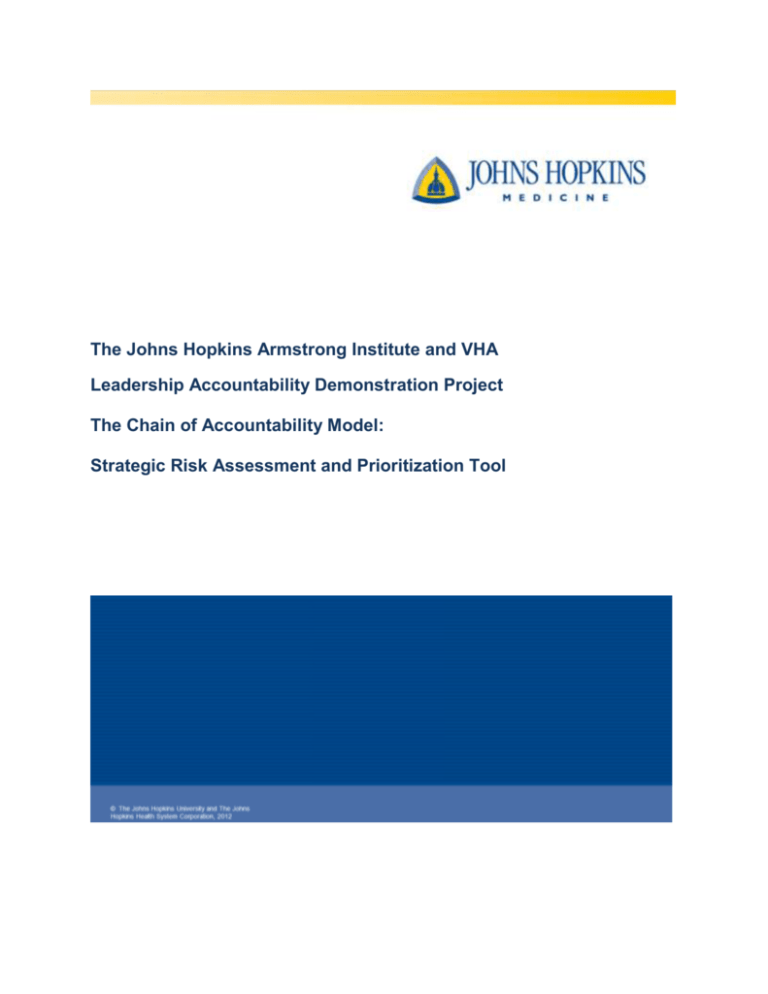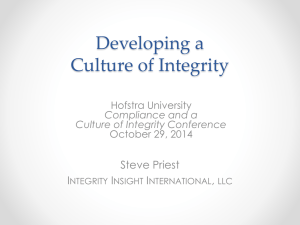Strategic Risk Assessment and Prioritization Tool
advertisement

The Johns Hopkins Armstrong Institute and VHA Leadership Accountability Demonstration Project The Chain of Accountability Model: Strategic Risk Assessment and Prioritization Tool Acknowledgements The Leadership Accountability Model and tool presented here were developed under funding by the VHA Foundation, contract # 113820, IO# 90052429. Please do not distribute without permission from the authors. Cite as Goeschel C, Rosen MA, Weaver SJ, Kosel, K., Gelinas, L., Ingle, R., Martin, J., Fawole, J.O., Che. X-X, Benson K., and Pronovost, P. (2013). The Armstrong Institute and VHA Chain of Accountability Model Workbook. Table of Contents The Armstrong Institute and VHA Model of the Chain of Accountability..................................................... 1 Strategic Risk Assessment and Prioritization Tool ........................................................................................ 2 The Armstrong Institute and VHA Model of the Chain of Accountability By viewing your organization through the Chain of Accountability lens, you can work to understand where vulnerabilities may be across levels of your organization. You can strengthen the chain by exerting force on three levers: accountability and feedback, capacity, and time and resources. We will introduce and work through a set of tools around this model during the cohort and individual site calls. We launched our project with the first of these tools - Aligning Goals and Accountability across the Organization. This tool can be used to examine how an organizational goal cascades across the levels of your organization. The tool detailed in this document—the Strategic Risk Assessment and Prioritization Tool—provides a structured way for an organization to set its high level priorities. Use the Strategic Risk Assessment and Prioritization Tool to ensure that the organization is focusing efforts in appropriate areas of concentration. This tool will ask leaders to asses reputational, financial, and 4|Page patient harm risks. This process will require input from across the chain of accountability and inform a sound organizational strategy which balances multiple competing demands and risks. Strategic Risk Assessment and Prioritization Tool Leading with Intent: What is our aim? Leaders at all levels in healthcare are challenged to make sense of what often seem like competing quality and patient safety demands. Often leaders are using limited resources, to achieve goals set by others, that often seem unattainable and at times, “locally not a priority”. As cost, quality, access and reimbursement become increasingly intertwined, tools are needed to help executives work with their teams on a systems approach to effectively and thoughtfully align internal and external efforts. The AI Risk Assessment and Prioritization Tool is one example of a tool and a process that is helping teams successfully address this challenge. The tool assumes leadership teams strive to: 1. Create High Value Healthcare Reduce preventable harm (central focus) Improve patient outcomes and experience Reduce costs of care 2. Acknowledge, Align and Prioritize Competing Improvement Goals and Priorities Clinical Outcomes Patient/Family Reported Outcomes 4|Page Staff Reported Outcomes Financial Goals/Measures of Efficiency 3. Implement an Effective Process for measuring and reevaluating goals and performance How do we consider financial, reputational, and regulatory risks associated with our performance? How do we balance external priorities with internal priorities? Use of the tool involves two phases, often conducted over a period of hours in the case of “urgent” assessment needs, but more often conducted over a period of many weeks to allow for ample data collection, team assessment, and thoughtful decision making. Phase I: Identify/Clarify External Reporting Risks, then Prioritize Action Areas Patient Risk/Harm Regulatory Risk Reputational Risk Financial Risk Feasibility Risk Once the tool is complete, leaders use the information to understand real or perceived risks, prioritize areas for improvement, allocate/align resources and guide decision making. How to Use the External Risk Assessment Grid External Risk Assessment Process In the external risk assessment grid list externally driven performance measures for your hospital, then rank them in terms of perceived risk, using the scale below*: Patient risk/harm L - Measure indicates potential for low patient harm and/or has limited to no evidence 4|Page M - Measure indicates potential for moderate patient harm and/or has ample evidence H - Measure indicates potential for severe patient harm and/or has strong and compelling evidence Financial Risk (includes penalty, rewards, and opportunity cost) L - Not a pay for performance/reporting initiative with < $ XK at stake* M - Pay for performance/reporting initiative with ≥ XK and < $XXK at stake* H - Pay for performance/reporting initiative with ≥ $XXK at stake* Reputational Risk L - Not publicly reported or evaluated by any external agency M - Reported or evaluated by external agencies but not shared publicly H - Publicly reported or evaluated by one or more regulatory and external agencies important to your organization (Leapfrog, Consumers Union, Healthgrades, local or regional rating agencies etc.) * If multiple external risks are labeled as “high” it may be necessary to conduct a second round of ranking, using a scale that allows for more granularity ~ A scale from 1-5 or 1-10 is generally sufficient to provide clarity. 4|Page Strategic Risk Assessment and Prioritization Grid Measure Performance Target Actual 4|Page Patient Risk/harm Regulatory Risk Reputational Risk Financial Risk Feasible Interventions Overall Priority Responsibility For Next Steps Follow-up Date






![Action Plan Training for College of Education [Erickson Hall]](http://s3.studylib.net/store/data/006838784_1-e08201da1f024d72d03dde66b95777a5-300x300.png)
